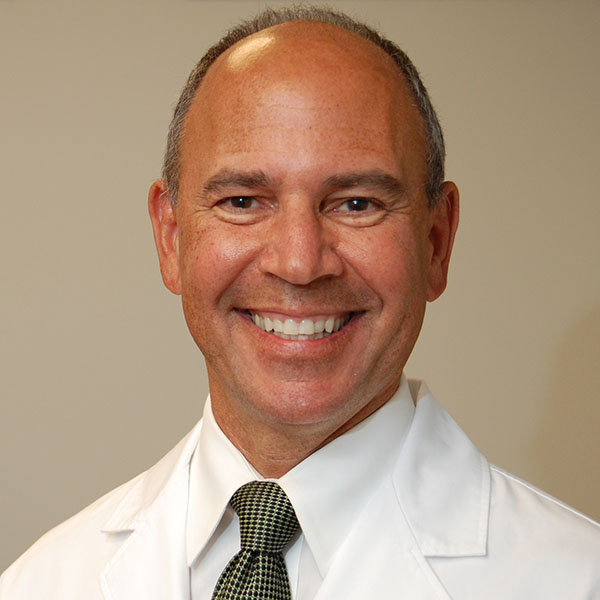
Prostate cancer: Short-course radiation as effective as longer-term treatments

It used to be that radiation therapy for prostate cancer involved weeks or months of repeat visits to a clinic for treatment. Today that’s not necessarily true. Instead of giving small doses (called fractions) per session until the full plan is completed, radiation delivery is moving toward high-dose fractions that can be given with fewer sessions over shorter durations.
This “hypofractionated” strategy is more convenient for patients, and mounting evidence shows it can be accomplished safely. With one technology called stereotactic body radiation therapy (SBRT), patients can finish their treatment plans within a week, as opposed to a month or more. Several devices are available to deliver hypofractionated therapy, so patients may also hear it referred to as CyberKnife or by other brand names.
An SBRT session takes about 20 to 30 minutes, and the experience is similar to receiving an x-ray. Often, doctors will first insert small metal pellets shaped like grains of rice into the prostate gland. Called fiducials, these pellets function as markers that help doctors target the tumor more precisely, so that radiation beams avoid healthy tissue. During treatment, a patient lies still while the radiation-delivery machine rotates around his body, administering the therapy.
How good is SBRT at controlling prostate cancer? Results from a randomized controlled clinical trial show that SBRT and conventional radiotherapy offer the same long-term benefits.
How the study was conducted
The trial enrolled 874 men with localized prostate cancer, meaning cancer that is still confined to the prostate gland. The men ranged between 65 and 74 years in age, and all of them had prostate cancer with a low or intermediate risk of further progression. The study randomized each of the men to one of two groups:
- Treatment group: The 433 men in this group each got SBRT at the same daily dose. The treatment plan was completed after five visits given over a span of one to two weeks.
- Control group: The 441 men in this group got conventional radiotherapy over durations ranging from four to 7.5 weeks.
None of the men received additional hormonal therapy, which is a treatment that blocks the prostate cancer–promoting effects of testosterone.
What the study showed
After a median duration of 74 months (roughly six years), the research found little difference in cancer outcomes. Among men in the treatment group, 26 developed visibly recurring prostate cancer, or a spike in prostate-specific antigen (PSA) levels suggesting that newly-forming tumors were somewhere in the body (this is called a biochemical recurrence). By contrast, 36 men from the control group developed visible cancer or biochemical recurrence. Put another way, 95.8% of men from the SBRT group — and 94.6% of men in the control group — were still free of prostate cancer.
A word of caution
Earlier results published two years into the same study showed higher rates of genitourinary side effects among the SBRT-treated men. Typical genitourinary side effects include inflammatory reactions that increase pain during urination, or that can make men want to urinate more often. Some men develop incontinence or scar tissues that make urination more difficult. In all, 12% of men in the SBRT group experienced genitourinary side effects at two years, compared to 7% of the control subjects.
“Interestingly, patients who were treated with CyberKnife appeared to have lower significant toxicity at two years compared with those treated on other platforms,” said Dr. Nima Aghdam, a radiation oncologist at Beth Israel Deaconess Medical Center and an instructor of radiation oncology at Harvard Medical School. By five years, the differences in side effects between men treated with SBRT or conventional radiation had disappeared.
The authors advised that men might consider conventional radiation instead of SBRT if they have existing urinary problems before being treated for cancer. Patients with baseline urinary problems are “more likely to have long-term toxic effects,” the authors wrote, adding that the new findings should “allow for better patient selection for SBRT, and more careful counseling.”
“This is an important study that validates what’s becoming a standard practice,” said Dr. Marc Garnick, the Gorman Brothers Professor of Medicine at Harvard Medical School and Beth Israel Deaconess Medical Center, and editor in chief of the Harvard Medical School Guide to Prostate Diseases. “The use of a five-day treatment schedule has been well received by patients who live long distances from a radiation facility, given that treatment can be completed during the weekdays of a single week. As with any cancer treatment choice, the selection of the appropriate patient is crucial to minimize any potential side effects, and this can only be done after a careful consideration of the patient’s other medical conditions.”
“This elegant study will put to rest any questions regarding the validity of SBRT as a standard-of-care option for many patients with prostate cancer,” Dr. Aghdam added. “Importantly in this trial, we see excellent outcomes for many patients who were treated with radiation alone. As this approach gains broad acceptance in radiation oncology practices, it remains critical to carefully consider each patient based on their baseline characteristics, and employ the highest level of quality assurance in delivering large doses of radiation in fewer fractions. As the overall duration of radiation therapy gets shorter, every single treatment becomes that much more important.”
About the Author

Charlie Schmidt, Editor, Harvard Medical School Annual Report on Prostate Diseases
Charlie Schmidt is an award-winning freelance science writer based in Portland, Maine. In addition to writing for Harvard Health Publishing, Charlie has written for Science magazine, the Journal of the National Cancer Institute, Environmental Health Perspectives, … See Full Bio View all posts by Charlie Schmidt
About the Reviewer

Marc B. Garnick, MD, Editor in Chief, Harvard Medical School Annual Report on Prostate Diseases; Editorial Advisory Board Member, Harvard Health Publishing
Dr. Marc B. Garnick is an internationally renowned expert in medical oncology and urologic cancer. A clinical professor of medicine at Harvard Medical School, he also maintains an active clinical practice at Beth Israel Deaconess Medical … See Full Bio View all posts by Marc B. Garnick, MD

Feel like you should be drinking less? Start here

When experts talk about the dangers of excessive drinking, we often assume those warnings apply mostly to people with alcohol use disorder, a health issue sometimes referred to as alcoholism.
But people who don’t meet formal criteria for this disorder can still experience toxic effects and suffer other serious harms from alcohol, says Dr. John F. Kelly, professor of psychiatry in addiction medicine at Harvard Medical School. And as research turns up new evidence about alcohol, many people are considering the benefits of drinking less, even if they’re not ready to stop imbibing entirely.
How does alcohol affect the body?
That depends on how much you drink. Drinking more than moderate amounts of alcohol (defined as one drink per day for women and two for men) increases your risk for developing
- liver disease
- several types of cancer including breast, liver, and colon cancer
- cardiovascular problems such as high blood pressure and atrial fibrillation.
What if you’re not drinking daily? “Even people who only drink on weekends can have serious accidents if they become intoxicated — for example, by falling or driving under the influence,” says Dr. Kelly.
What’s more, growing evidence suggests that even small amounts of alcohol may harm your health.
How could cutting down on alcohol help you?
If you’re not ready to give up drinking entirely, cutting back can lower the likelihood of all of these harms. For example, cutting down on alcohol, or stopping entirely, is linked with lower cancer risks, according to a report from the American Association for Cancer Research.
You might also notice some immediate benefits, like sleeping more soundly, memory improvements, and generally feeling more mentally sharp. And because you’ll be taking in fewer calories, you may also shed some weight.
Ready to try cutting back on alcohol? Start here
These five suggestions are a great way to start cutting back.
Keep a drinking diary
Tracking how much alcohol you drink and when can help you target your efforts to drink less. It’s also a good idea to put your reasons for cutting back in writing: for example, “I’d like to sleep better,” “I feel sharper,” “Better heart health is important to me.” That practice can reinforce your resolve to follow through with your plan.
Try alcohol-free days — or even a month of not drinking
Taking a break from alcohol can be a good way to start, allowing your brain and body to recalibrate. Decide not to drink a day or two each week. You may want to abstain for a week or a month, to see how you feel physically and emotionally without alcohol in your life. Consider doing Sober October — a variation of Dry January.
Drink slowly and with food
Sip your drink. Alternate alcoholic drinks with nonalcoholic alternatives like sparkling water, soda, or juice. Don’t drink on an empty stomach, because you’ll feel intoxicated more quickly. That can lower your inhibitions and break your resolve to stick to lower amounts of alcohol, Dr. Kelly says. Drinking with a meal slows alcohol absorption and appears to minimize the drug’s health risks.
Try low-alcohol or zero-alcohol substitutes
Alcohol-free beer, nonalcoholic distilled spirits, and similar products have become more widely available in recent years. It’s a result of the alcohol industry’s response to stay profitable, as health harms of small amounts of alcohol have been confirmed and the sober curious movement gains momentum.
If you drink beer, wine spritzers, hard seltzer, or similar products, check the alcohol content
While light beers have fewer calories, they don’t necessarily have much less alcohol than regular beer. The average light beer is about 4.3% alcohol, versus 5.0% in regular beer.
Also, be aware that some craft or specialty beers contain far higher amounts of alcohol — up to 12% or 14% or even higher. Beverages that combine wine or hard liquor with seltzer or other mixers also vary widely in their alcohol content.
Cut down on temptation
Two more tips can help you meet success when changing drinking habits.
Don’t keep alcohol in your house. Making your home an alcohol-free zone takes away the risk of immediate temptation.
Avoid temptation. Steer clear of people and places that make you want to drink. If you associate drinking with certain events, such as holidays or vacations, make a plan for managing these situations in advance. Check in with your feelings. When you’re worried, lonely, or angry, you might be tempted to reach for a drink. “Think about other ways you might alleviate those feelings, such as going for a walk or calling a friend,” Dr. Kelly suggests.
Finally, try this interactive tool from the CDC, which can help you make a personalized plan to drink less.
About the Author

Julie Corliss, Executive Editor, Harvard Heart Letter
Julie Corliss is the executive editor of the Harvard Heart Letter. Before working at Harvard, she was a medical writer and editor at HealthNews, a consumer newsletter affiliated with The New England Journal of Medicine. She … See Full Bio View all posts by Julie Corliss
About the Reviewer

Howard E. LeWine, MD, Chief Medical Editor, Harvard Health Publishing; Editorial Advisory Board Member, Harvard Health Publishing
Dr. Howard LeWine is a practicing internist at Brigham and Women’s Hospital in Boston, Chief Medical Editor at Harvard Health Publishing, and editor in chief of Harvard Men’s Health Watch. See Full Bio View all posts by Howard E. LeWine, MD